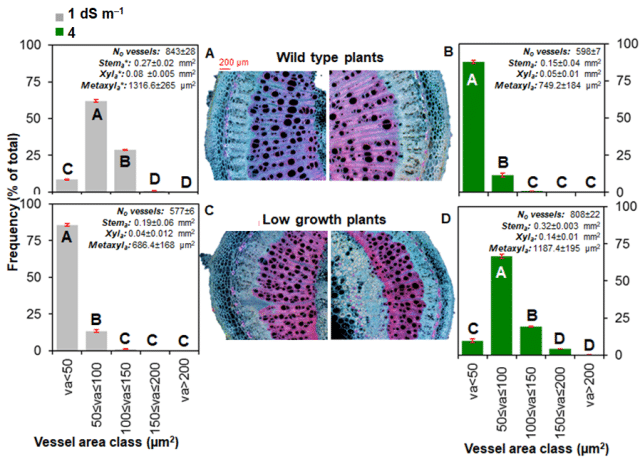
Shorter Roots and Wider Conduits Regulate Plant Hydraulic Integrity under Impaired Stomatal Control and Salinity Conditions
2Institute of Soil, Water and Environmental Sciences, The Volcani Center, Agricultural Research Organization, Israel
3Department of Botany and Zoology, Federal University of Rio Grande do Norte, Natal, Brazil
4The Robert H. Smith Institute of Plant Sciences and Genetics in Agriculture, Faculty of Agricultural, Food & Environmental Quality Sciences, The Hebrew University of Jerusalem, Rehovot, Israel
Plants maximize their diurnal photosynthetic productivity without risking their hydraulic integrity by constantly updating their stomata resistance to balance environmental water deficits. Without an effective transient hydraulic regulation provided by stomata, we postulated that plants would shift its xylem anatomy, shorten roots, and thus promote a constantly restrain of its hydraulic conductivity. To test this, we compared wild type (WT) tomatoes to a low-growth (LG) transgenic type with narrow conduits and short roots. We exposed the plants to irrigation salinity of 1 and 4 dS m-1 during 60 days, tracked their diurnal transpiration in an automated lysimetric system, and analysed their midday photosynthetic performance. Plant biomass, starch content, root length, tissue mineral composition and anatomical analysis of the main stems were also determined. Narrow conduits and shorter roots did substitute for stomatal regulation in the LG type and forced them to lower transpiration and growth rates, following the vapour pressure deficit. Under salinity, WT minimized transpiration by shutting stomata and reducing growth, while LG plants were not able to restrain water loss due to impaired stomatal activity. Moreover, LG plants grown in salinity had lower root length but wider conduits, which seems counter-rational from a physiological perspective, but makes perfect physical sense. Salinity reduced the water potential difference between the plant and the environment, and LG tomatoes could relax their hydraulic resistance. These plants continued to photosynthesize to no avail, as their growth was stunned and their photosynthates accumulated in their leaves, while they accumulated toxic ions. It implies that without transient hydraulic control, plants are governed by the environment, which is photosynthetically inefficient at best, and hazardous in bad times.

Fig 1 Frequency of vessel area and transversal sections of the main stem of tomato plant stained with safranin-fast green and viewed under dark-field microscopy. Xylem vessels appear in pink color. Unstressed WT plants (A); salt-stressed WT plants (B); unstressed LG plants (C); and, salt-stressed LG plants (D). *Number of vessels, stem area, xylem and metaxylem areas are presented (average ± SD). Different capital letters indicate significant differences between the frequency of vessel area classes at the P = 0.05 level.

Fig 2 Total leaf area (A), total root length (B), root to leaf surface area ratio (C); and, root to shoot dry matter ratio (D) at 60 DAT. Each point represents average values of the repetitions. Standard error bars are shown (n = 4). Single asterisks represents significant differences from WT plants at the P = 0.05 level. Different capital letters indicate significant differences between varieties for each salinity treatment at the P = 0.05 level. Different lowercase letters indicate significant differences between salinity treatments for each variety at the P = 0.05 level.
Powered by Eventact EMS